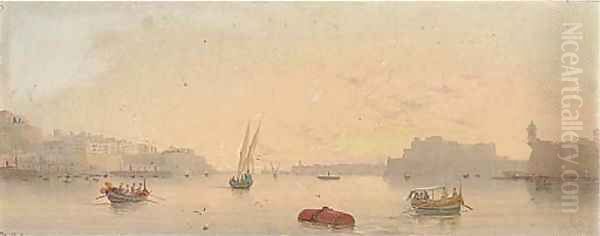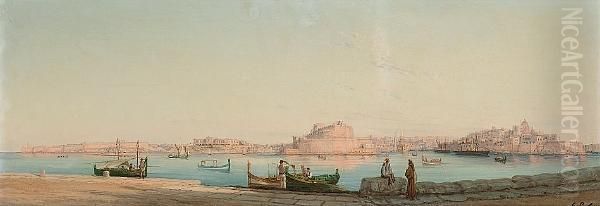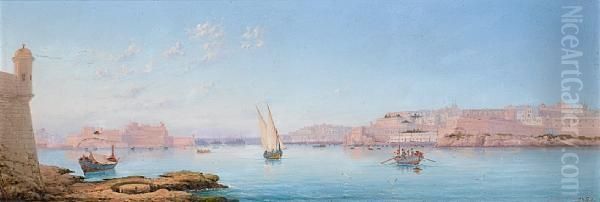Luigi Maria Galea stands as a figure within the artistic heritage of Malta, primarily recognized through his connection to specific works and a style rooted in classical observation. While details about his life remain somewhat fragmented, his contributions offer a glimpse into the Maltese cultural and historical landscape of the 19th century. His work, particularly his depictions of Valletta's iconic Grand Harbour, places him within a tradition of European maritime and topographical painting, yet imbued with a distinct Maltese identity.
Understanding Galea requires navigating sources that sometimes present varied information, particularly regarding his professional background. However, his identity as an artist is consistently highlighted, linked to tangible works that survive today. Exploring his art involves appreciating the technical skill attributed to him and the cultural context from which his creations emerged.
Nationality and Background
Luigi Maria Galea's nationality is firmly established as Maltese. He is intrinsically linked to the archipelago, and his known works often celebrate its unique character and history. Malta, with its strategic location in the Mediterranean and its rich, layered past involving the Knights of St. John, French, and British rule, provided a fertile ground for artists seeking dramatic landscapes and historical narratives. Galea appears to have drawn inspiration directly from this environment.
There is some ambiguity in historical records regarding his precise professional activities. While primarily identified as an artist, particularly the painter of the notable work 'Grand Harbour, Valetta, Malta', some sources associate the name Luigi Maria Galea with the profession of an accountant and auditor. It is mentioned that a person of this name was a Certified Public Accountant, involved in business consultancy and serving on boards of listed companies.
Given the historical period typically associated with the artist Galea (mid-19th century), the description of a modern financial professional seems incongruous. This discrepancy might suggest two different individuals sharing the same name, or perhaps incomplete or conflated records. For the purposes of art historical discussion, the focus remains firmly on Luigi Maria Galea, the Maltese artist whose work reflects the visual culture of his time. His artistic identity is the one substantiated by attributed artworks.
Artistic Style and Influences

The artistic style of Luigi Maria Galea is generally characterized as classical. This suggests an adherence to principles of order, balance, clarity, and a faithful representation of the subject matter. Sources note his "keen eye for detail" and the creation of "elegant decorative works." This points towards a meticulous approach, likely involving careful drawing, precise rendering of architectural and natural elements, and a polished finish.
His focus on detail aligns well with the tradition of topographical painting, or 'vedute', which was popular across Europe. Artists like the Venetian masters Canaletto (Giovanni Antonio Canal) and Francesco Guardi, known for their detailed views of Venice, set a high standard for this genre. While operating in a different geographical context, Galea's depiction of the Grand Harbour likely shared this commitment to accuracy in portraying the bustling port and its surrounding fortifications.
The description of his work as "elegant" might also imply a certain refinement and perhaps a degree of idealization, common in classical and neoclassical aesthetics. This contrasts with the more turbulent and emotional approach of Romanticism, although landscape and maritime painters of the era, such as the British master J.M.W. Turner, often blended meticulous observation with dramatic atmospheric effects. It remains unclear from the available information how Galea balanced objective representation with artistic interpretation. His style might also show influences from other Maltese artists active around the same period, such as members of the Schranz family, known for their maritime paintings and views of Malta.
Furthermore, the mention of "decorative works" could encompass a broader range of activities beyond easel painting, potentially including designs for interiors or specific objects, aligning with the classical tradition's integration of art into various aspects of life. This resonates with his reported involvement in church decoration, suggesting a versatility often expected of artists before the stricter specializations of later periods. The influence of major European neoclassical figures like Jacques-Louis David or Jean-Auguste-Dominique Ingres, who championed line and form, might also be considered as part of the broader artistic climate Galea worked within.
The Grand Harbour of Valletta
Luigi Maria Galea's most frequently cited work is his painting titled 'Grand Harbour, Valetta, Malta'. This subject is one of the most iconic and historically significant locations in the Mediterranean. The Grand Harbour, with its imposing fortifications built by the Knights of St. John and its role as a major British naval base in the 19th century, offered artists a wealth of visual and historical material.

There appears to be some confusion in the sources regarding the precise dating of this work. One reference mentions a painting depicting an event in 1847 – specifically the launch of the British naval vessel HMS Niger and referencing the Battle of Balaclava. However, the Battle of Balaclava took place in 1854 during the Crimean War, making the 1847 date problematic if the reference is accurate. Another source dates the painting 'Grand Harbour, Valetta, Malta' to the period between 1854 and 1856, linking it to a time of commercial prosperity for the harbour. This later dating aligns better with the Crimean War context if the Balaclava reference is indeed tied to this specific painting.
Regardless of the exact date, a painting of the Grand Harbour by Galea, executed in his detailed classical style, would likely capture the vibrant activity of the port. One might expect to see various vessels – naval ships, merchant boats, traditional Maltese dgħajjes – set against the backdrop of Valletta's distinctive architecture and the massive limestone bastions. Such a work would serve not only as an artistic representation but also as a historical document of Malta's maritime importance during the British period.
The choice of the Grand Harbour as a subject places Galea within a long line of artists captivated by this view, including earlier figures and later painters. The level of detail attributed to him suggests a work that invites close inspection, revealing specifics of ship design, waterfront activity, and the unique interplay of light on the water and stone, characteristic of the Maltese islands. The painting would likely emphasize the grandeur and strategic significance of the location.
Contributions to Maltese Culture
Beyond specific paintings, Luigi Maria Galea is associated with the broader expression of Maltese culture, often referred to as 'Melitensia'. This suggests his work was perceived as capturing something essential about the island's identity, history, or landscape. His focus on recognizable Maltese scenes like the Grand Harbour is a clear example of this engagement with local subject matter.
Interestingly, sources also link Galea to silversmithing. It is mentioned that works related to him are held in the collection of the Mdina Cathedral Museum. Mdina, the ancient capital of Malta, and its cathedral museum house significant collections of Maltese art and artifacts, including ecclesiastical silver. If Galea was involved in designing or even crafting silver objects, it would demonstrate considerable artistic versatility. Maltese silversmithing has a long and distinguished history, particularly during the time of the Knights, and continued to be an important craft.

This potential involvement in silver work, alongside painting and possibly decorative design, paints a picture of an artist engaged with Maltese heritage through multiple mediums. Such versatility was not uncommon for artists in earlier centuries. His work, whether on canvas or in precious metal, appears rooted in a desire to represent and contribute to the cultural fabric of Malta. This dedication to 'Melitensia' positions him as an artist conscious of his national context.
The collection of his work or related items in a prominent museum like the Mdina Cathedral Museum underscores his recognition within Malta's cultural heritage. It suggests that his contributions were deemed significant enough for preservation and display, offering insights into the artistic production of his era.
Involvement with St. George's Basilica
Luigi Maria Galea is also mentioned in connection with the decorative design of St. George's Basilica in Victoria, Gozo (Malta's sister island). St. George's Basilica is one of the most important churches in Gozo, often called the 'Marble Basilica' due to its rich interior decoration. The sources state Galea "participated" in the decoration design, showcasing his talent in architectural and decorative arts.
The descriptions provided in the source material about the Basilica's decoration – mentioning specific colours, materials like marble and brass, patterns, icons, stained glass, and architectural elements in an Italianate or classical style – paint a picture of a lavishly adorned interior. However, the sources do not specify the exact nature or extent of Galea's contribution. Did he design specific elements, oversee parts of the work, or create paintings or murals within the church? This remains unclear.
St. George's Basilica underwent various phases of construction and decoration over centuries. Its current opulent Baroque interior largely dates from works carried out in the 20th century, although the structure is older, and decorative campaigns occurred earlier as well. If Galea worked there in the mid-19th century, his contribution would likely align with the neoclassical or eclectic tastes of that period, perhaps involving specific altarpieces, ceiling paintings, or decorative schemes that might have been later altered or incorporated into subsequent renovations.
The tradition of artists contributing to church decoration is very strong in Malta and Gozo, with notable examples including the extensive work by the Italian Baroque master Mattia Preti in St. John's Co-Cathedral in Valletta. Other artists, both Maltese and foreign, have adorned numerous churches across the islands. Galea's reported involvement places him within this significant tradition of sacred art, linking his classical style and eye for detail to the embellishment of an important religious edifice. Famous artists like Michelangelo and Raphael were also deeply involved in major religious commissions, highlighting the historical prestige associated with such work.
Context and Contemporaries
Information regarding Luigi Maria Galea's direct interactions – collaborations or rivalries – with other artists of his time is lacking in the provided sources. The art world, particularly in concentrated centres, often involves complex relationships between artists, patrons, and institutions. While rivalries like that between Michelangelo and Raphael in Renaissance Rome, or later competitions for commissions, are well-documented aspects of art history, no such specific dynamics are recorded for Galea.
However, we can place him within the broader context of 19th-century European art. His classical style and detailed topographical work connect him to Neoclassicism and the tradition of the 'veduta'. He worked during a period when Romanticism was also a major force, emphasizing emotion, individualism, and the sublime aspects of nature, often seen in the works of Eugène Delacroix or the dramatic seascapes of Turner. Photography was also emerging as a new medium for representation.
In Malta itself, Galea would have been contemporary with or successor to artists like Giuseppe Calì, a prolific Maltese painter known for his portraits and religious works, though Calì's main activity stretches into the early 20th century. The aforementioned Schranz family were also prominent. Foreign artists also visited and worked in Malta, attracted by its climate, history, and picturesque views. For instance, the British writer and artist Edward Lear, known for his nonsense verse and his landscape paintings, visited Malta several times in the mid-19th century and sketched its scenery.
The presence of the British Royal Navy, as potentially depicted in Galea's Grand Harbour painting, also brought a specific cultural influence and patronage source to the islands. Maritime painting was a well-established genre in Britain and other naval powers. Galea's work can be seen as a Maltese contribution to this genre, perhaps influenced by British maritime artists or responding to the demand for such views. The legacy of earlier artists who spent time in Malta, such as Caravaggio in the early 17th century, while distant in time, contributed to the island's rich artistic aura. Galea worked within this layered history, contributing his own detailed observations of Maltese life and landscape. Other Italian view painters like Bernardo Bellotto, Canaletto's nephew, also perfected the detailed cityscape, a tradition Galea seems to echo.
Legacy and Conclusion
Luigi Maria Galea remains a somewhat enigmatic figure in Maltese art history, known primarily through a key work, 'Grand Harbour, Valetta, Malta', and associations with Maltese culture, silversmithing, and church decoration. His artistic identity is defined by a classical style emphasizing meticulous detail and elegant representation, placing him within the European tradition of topographical and maritime painting.
The inconsistencies in dating his most famous work and the conflicting information regarding his profession highlight the need for further research to establish a clearer biography and catalogue of works. What is clear is his connection to Malta and his contribution to depicting its iconic scenery and participating in its cultural production, potentially across multiple artistic mediums. His work reflects the Malta of the mid-19th century, a period of British rule, maritime significance, and evolving artistic tastes.
While perhaps not possessing the international fame of some of the artists mentioned as contemporaries or influences, Galea holds a place within the narrative of Maltese art. His 'Grand Harbour' painting, capturing the majesty of Valletta's port, serves as a visual testament to his skill and his engagement with his homeland. His legacy lies in these contributions to 'Melitensia', offering a detailed, classical window onto the Malta of his time, appreciated within the collections of Maltese museums and potentially within the decorative fabric of Gozo's St. George's Basilica. He represents a strand of Maltese artistic identity navigating the currents of 19th-century European art while remaining focused on the unique character of the islands.